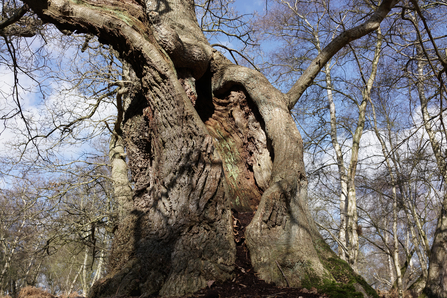
Veteran oak tree at Captain's Wood - Steve Aylward
Suffolk is well endowed with a large array of ancient or veteran trees. The great age, size and condition of these trees makes them a unique and vital habitat for wildlife. They are also a cherished feature of our landscape, giving atmosphere and richness to the countryside.
Our veteran trees form a tangible link with the wildwood that covered Britain two thousand years ago. Many veteran trees that we see today are direct descendants of these original trees and as such they form an irreplaceable gene pool.
What is a veteran tree?
The age at which a tree is classed as ‘veteran’ will vary according to species. Whilst there are no hard and fast rules on how to recognise a veteran tree, its general physical state should give a good indication of great age. A veteran tree will have reached the point in its lifespan when it is no longer growing vigorously and has therefore passed its useful commercial life.
Trees of a great age often have some decaying or dead wood either on the tree or on the ground where branches or parts of the tree have fallen.
Where are they found?
Many of the veteran trees in Suffolk that are still in existence today, started life as working trees which were regularly cut or pollarded for fuel and wood. These trees may therefore be found in places that are historically associated with human activity such as hedgerows, pasture, riversides, village greens, parkland, churchyards or even gardens.
Why are veteran trees so valuable to wildlife?
Veteran trees provide a vital habitat for many species of plants, birds, mammals and invertebrates. In fact, there are many species for which only very old trees provide suitable conditions. Many of the plants, animals and micro-organisms that are dependent on these trees, can also benefit and contribute to the longevity of the trees.
Veteran trees will have experienced a certain amount of decay – this is a natural process and is not usually a sign of ill health. In fact, this decay actually increases the wildlife value of the tree, including some of Suffolk’s rarest species. The fungi that
are often found on old trees help the decaying process and provide a vital recycling role, forming deadwood that is an important habitat for many species.
Hundreds of insect species need the special conditions provided by decay in veteran trees for laying eggs and feeding larvae. Ancient oaks, for example, provide habitat for the cardinal click beetle.
Sheltered and hollow interiors also provide a protected and stable environment for many species. The continuity of environment provided by veteran trees is important for many specialised communities of fungi, moss and lichen, for whom the bark and crevices make an ideal habitat.
What are the main threats to veteran trees?
• Damage by natural causes such as drought, strong winds, fire and flooding
• Development of land for housing or industrial use and the disappearance of old parklands and woods
What can I do to help veteran trees?
Here are some ideas, but call 01473 890089 and email info@suffolkwildlifetrust.org for more details:
• Plant a tree! Always try to plant native trees such as oak, ash, field maple and hornbeam, as these support a much better variety of wildlife.
• Consider planting standard trees when planting a hedge and allow them to grow through the hedge
• Become a tree warden or volunteer for the The Tree Council
• Do not ‘tidy’ the tree – leave dead branches on the tree or where they have fallen
• Do not pollard or rejuvenate the tree without consulting specialists
• Do not use pesticides, herbicides or fertilizers in vicinity of the tree
• Do not put soil or waste materials around the base of the tree and do not allow toxic materials such as fuels,
oils and road salt near the tree
• Avoid drastic change to the tree or its surroundings, such as compaction of the soil by trampling and vehicles, or ploughing too close to the roots
• Do not remove climbing plants such as ivy and rose, as these can usually be supported by a veteran tree without it suffering damage and provide excellent habitats for wildlife
